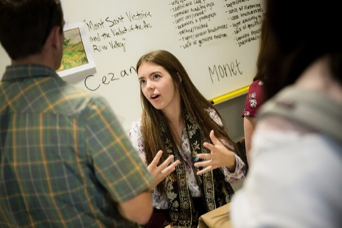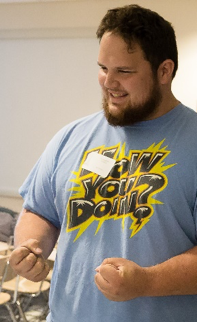Reacting to the Past
What is Reacting to the Past?

Reacting to the Past is an interdisciplinary pedagogical tool that buoys student engagement through the power of subversive, immersive play. Structured intellectual debate grounded in historical primary sources revolves around core questions that still resonate today. According to Carnes (2014), Reacting students learn historical content more deeply, acquire greater leadership and communication skills, develop stronger classroom communities and self-knowledge, and enthusiastically do more work than for non-Reacting coursework.
Historically grounded roles defined by multi-page role sheets guide play starting from a specific moment, with all the motivations and sources available to participants in that moment. As the students play the game out, what happened in history need not necessarily occur in the classroom. Inhabiting the mindsets of others requires students to step out of their comfort zones and learn their roles deeply, but it also provides a safe space to engage in civil discourse with opposing points of view. Students must remain faithful to their roles, employing the game manual’s documents within defined game mechanics, but they are free to attempt to change history.
Reacting classrooms can be messy spaces occupied by students in animated discussion. Roles participate either within factions, which are teams advocating for mutual goals, or as indeterminates, who are characters whose opinions are not yet settled (but should be over the course of the game). Once a professor has set the game in motion, they step back and observe, playing a supporting role by prompting individual students to advocate for their positions, assessing participation and speeches, and calling faction breaks as necessary when debate lags or an impasse is reached.
Implementation

- Find a game that fits your curriculum.
- Fully published games have game manuals for students to purchase like any other textbook.
- Games in development are undergoing peer review; all their materials can be downloaded for free from the password-protected Reacting Consortium Library.
- Additional games in the initial stages of development are listed in the Big List of Reacting Games (the BLORG) and may be available by contacting the authors directly
- Join the Facebook Reacting Faculty Lounge. This is the Room of Requirement for all things Reacting, and if you’re not sure about anything game-related (even what game to play), this is the place to ask. Access is restricted to verified instructors.
- Schedule the game into your syllabus. The Instructor Manual should have model schedules to help you determine how to organize class time over the course of multiple game sessions. Most games consist of:
- One to three days of setup, which may include background lecture, reading quizzes, in-depth reading of texts, and faction meetings;
- Two to six class sessions of actual game play; and
- A debriefing day to wrap up any loose ends from game play, to lecture on “what really happened,” and to help students reflect on their learning. Debriefing also serves as a way for students to exit from roles and potentially controversial game conflicts in a cathartic manner.
- Plan for class time to teach students how to React. Students may likely be uncomfortable with the tasks, particularly public speaking, involved in playing these games, not to mention the inevitable uncertainties associated with the pedagogy. Be prepared to spend class time, maybe a full session, addressing such student anxieties.
- Warm up exercises (see Lily Lamboy’s speaking videos) and public speaking ice breakers or improv activities can help students practice speaking with each other.
- Detail how evaluation/grading will work and what learning outcomes you expect from the game; if time allows, involve students in brainstorming both, to encourage ownership over their own takeaways from the game.
- Discuss the pros and cons of exploring history as contingent and counterfactual. Many students have learned that education is a game of getting as many things right as possible, and Reacting games will explicitly encourage individual actors to try to make history play out “wrong,” so that the resolution of the game may turn out differently from historical record. Help students consider (at the beginning but also throughout and after game play) what benefits might come from this counterintuitive approach, such as a greater understanding of individual agency and empathy with opposing viewpoints.
- If possible, attend an RTTP workshop. Though not a requirement, many instructors find that by playing an actual game themselves at a workshop run by seasoned Reactors, the pedagogical tactics become clearer. Reacting workshops frequently also include student panels, to hear students’ perspective on their learning.
- Read the Instructor Manual (IM) and Student Game Manual. This will provide you with the content background, help you understand student assignments and responsibilities, and familiarize you with the game mechanics (how students “win”). The Instructor Manual should also provide you with a play-by-play outline for what you need to orchestrate each day of the game, as well as what you should expect from particular student roles each class, to prompt them into action if they fail to act.
- Print out role sheets and faction advisories from the Instructor Manual. (If using a game in development, also print out or electronically distribute the Student Game Manual.) At least one day before the actual game play starts, each student in the class should receive a role and any associated faction advisories or handouts from the IM. Many model schedules indicate when roles should be distributed, although some instructors prefer to hand out roles a week or two before game setup to give students increased preparation time.
- Note: Faction advisories should be distributed to all and only members of a faction. Faction advisories as well as roles often contain game secrets that other players could take advantage of if widely known.
- Play the game! Run the scheduled setup day(s), prepare your students to take over, and on the first day of game play, sit at the back of the classroom with a pile of Post-its and let them take over the show. They may look at you uncomfortably and expect you to take control; despite any urges to step in and help them do it “right,” restrain yourself. Trust the process; give them verbal or written hints (on those Post-its) on how to engage if necessary, but don’t avoid the discomfort. Reacting gives students agency over their own learning, something they have rarely if ever been trusted with before. If you have provided a sufficient safety net in the setup, with reassurances on how grading works and guidance on how to have meaningful, respectful public discourse, brave students will step up to their tasks, and others will follow them.
Frequently Asked Questions
Can I use Reacting games even though I’m not an Historian?
- Although they were initially developed by Mark Carnes in the 1990s in History courses, thousands of professors worldwide now use Reacting to the Past in disciplines including STEM (Biology, Physics, Astronomy, Nutrition, Ecology), Political Science, English/Composition, Communication, Philosophy, Foreign Languages, Art and Art History, Economics, and Education.
How long do these games take?
- Reacting games last between three and eight class sessions; a series of shorter, one- or two-class games, called Flashpoints, are also in development.
But how do you sacrifice so much of your semester to a game? Don’t you lose important content?
- Student retention of content can be significantly greater when the deep immersion of the games is prioritized over breadth of coverage. Moreover, Reacting games help students develop skills like critical thinking, communication, and research that help them engage with why the content matters on a personal level. Over the longterm, such skills provide students with a sense of individual agency to investigate within the field(s) of knowledge covered in a game. Moreover, games necessarily introduce a broad range of themes and issues that can connect widely to course content beyond the game. Some instructors find that these factors allow them to address “missing” content much more readily during classes before, after, and between games than they might otherwise be able to do.
What size classes can you play these games in?
- Games typically include between twelve and thirty-five individual roles; games can be upsized for larger classes by assigning teams of two or more students to a single role, dividing the tasks of research, writing, speaking, and scheming amongst the team. Some games can be downsized for smaller classes; if the Instructor’s Manual does not address downsizing, inquire in the Facebook Faculty Lounge for suggestions.
How do you grade this?
- Like any other assessment practice, grading of in-game performance should be directly tied to students’ demonstration of learning outcomes. Reacting instructors approach this question in as diverse of ways as there are assessment techniques. Consult the Facebook Faculty Lounge for model grading rubrics that other instructors have posted.
If Reacting games can deviate from history, how do you get students to learn what actually happened?
- Debriefing sessions at the end of each game provide an opportunity for instructors to set the record straight. Deviations from historical record often provide the most important teachable moments in a game, because they help students see how individual choices can impact major decisions. Moreover, counterfactual history within games helps illuminate perspectives that have historically been erased in narratives which prioritize only the outcomes of historical events rather than the processes that led up to them.
How do students like Reacting?
- Like any other pedagogical approach, students’ opinions vary. However, most proponents of Reacting are more concerned with whether students learn more and better, and if they can recognize their improved learning, over the popularity of the games (although the games can be immensely popular).
References
Carnes, M. (2014). Minds on Fire: How Role-Immersion Games Transform College. Cambridge, MA: Harvard University Press.
Game Resources:
Barnard College. “Games in development.” Reacting to the Past. Accessed on Feb. 27, 2019, available at reacting.barnard.edu/curriculum/games-in-development.
Barnard College. “Published games.” Reacting to the Past. Accessed on Feb. 27, 2019, available at reacting.barnard.edu/curriculum/published-games.
Lamboy, L. (speaking videos). Accessed on Feb. 27, 2019, available at youtube.com/playlist?reload=9&list=PLB3812C4C74248B47 (YouTube playlist
compiled by Shoshana Brassfield).
Proctor, N., compiler. Big List of Reacting Games: BLORG. Accessed on Feb. 27, 2019, available at: docs.google.com/spreadsheets/u/1/d/1GkDM2eHFRl5zv0NA7tz6HZKRsKum603sl8k343MFXsc/pub?output=html (Google Sheets document).
Reacting Consortium Library. Accessed on Feb. 27, 2019, available at reactingconsortiumlibrary.org/.
Reacting Faculty Lounge. Accessed on Feb. 27, 2019, available at facebook.com/groups/reactingfacultylounge/ (Facebook group).
Cite this resource: Gasper-Hulvat, M. (2019). Active Learning – Reacting to the Past. Kent State University Center for Teaching and Learning.
Retrieved [today's date] from [insert URL]

